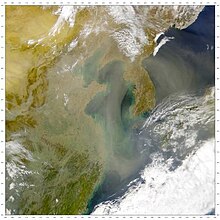| Yellow Dust (China Dust) | |||||||||||||||||||||||||||||
|---|---|---|---|---|---|---|---|---|---|---|---|---|---|---|---|---|---|---|---|---|---|---|---|---|---|---|---|---|---|
 Dust clouds leaving mainland China and traveling toward Korea and Japan | |||||||||||||||||||||||||||||
| Chinese name | |||||||||||||||||||||||||||||
| Traditional Chinese | 黃沙 | ||||||||||||||||||||||||||||
| Simplified Chinese | 黄沙 | ||||||||||||||||||||||||||||
| |||||||||||||||||||||||||||||
| Vietnamese name | |||||||||||||||||||||||||||||
| Vietnamese | bão cát vàng | ||||||||||||||||||||||||||||
| Korean name | |||||||||||||||||||||||||||||
| Hangul | 황사 | ||||||||||||||||||||||||||||
| Hanja | 黃沙 or 黃砂 | ||||||||||||||||||||||||||||
| |||||||||||||||||||||||||||||
| Japanese name | |||||||||||||||||||||||||||||
| Kanji | 黄砂 | ||||||||||||||||||||||||||||
| Kana | こうさ | ||||||||||||||||||||||||||||
| |||||||||||||||||||||||||||||

Asian Dust (also yellow dust, yellow sand, yellow wind or China dust storms) is a meteorological phenomenon that affects much of East Asia year-round and especially during the spring months. The dust originates in the deserts of China, Mongolia, and Kazakhstan, where high-speed surface winds and intense dust storms kick up dense clouds of fine, dry soil particles. These clouds are then carried eastward by prevailing winds and pass over China, North and South Korea, and Japan, as well as parts of the Russian Far East. Sometimes, the airborne particulates are carried much further, in significant concentrations which affect air quality as far east as the United States.
Since the turn of the 21st century, coinciding with the rapid industrialization of China, yellow dust has become a serious health problem due to the increase of industrial pollutants contained in the dust. Intensified desertification due to deforestation has been causing longer and more frequent occurrences. The issue has been exacerbated as the Aral Sea of Kazakhstan and Uzbekistan has largely dried up. This started in the 1960s with the diversion of the Amu River and Syr River, as part of a Soviet agricultural program to irrigate Central Asian deserts, mainly for cotton plantations.
- ^ "気象庁|黄砂に関する基礎知識". www.data.jma.go.jp (in Japanese). Retrieved January 2, 2021.